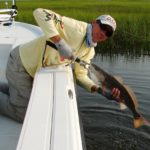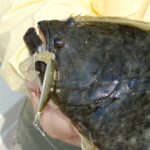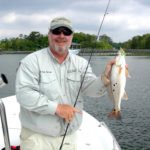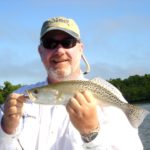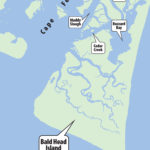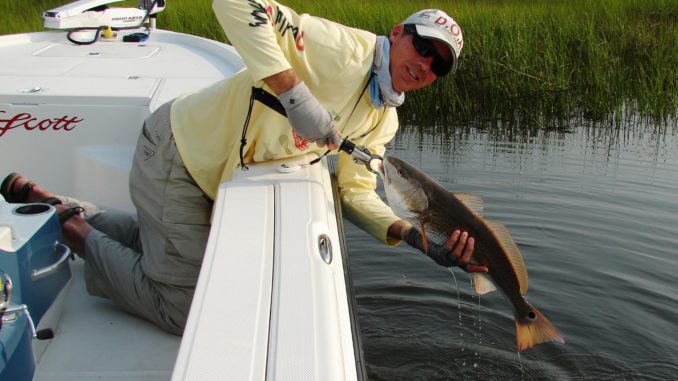
Redfish, flounder and trout are frequently caught by fishermen who learn the ins and outs of Bald Head Island’s marsh.
The small schools of minnows, swept down the little marsh creek on the falling tide, seemed to get nervous as it crossed a spot just a few yards inside the creek’s mouth. The baitfish knew they were being forced by the receding waters to leave the safety of the deep marsh behind Bald Head Island, and they were moving quickly.
But at this one spot where the grass kicked out into the creek a little, every one made a quick dart as if something had spooked them.
As guides Rick Bennett and Stu Caulder watched another group of the minnows being pushed out the creek by the tide, the water erupted — a big splash right in the middle of the school of minnows — then the water calmed, and in just a few seconds, it was as if nothing had happened.
“Did you see that?” Bennett asked Caulder, his excitement evident. “I was pretty sure there was something spooking all the bait coming out that creek, but that proves it. Did you see what it was? All I saw was the splash. Let me get this reeled in, and I’ll cast in there to see if it’s still hungry.”
Bennett dropped a cast a few yards up the creek, beyond the small point of grass, and began working his bait back with the current. Nothing happened, so he cast several more times. Just when he was beginning to think that whatever had struck the minnows was gone, there was a solid thump, and the lure stopped.
Experience kicked in, and Bennett recognized the bite was from a flounder. He relaxed for a couple of seconds, then tightened down the line, and when he felt resistance, he leaned back and set the hook.
Bennett’s rod began to pulse; at first, the flounder pulled away, but then it turned and ran out of the small creek. It took a little line and then settled down for a battle of tug-of-war battle. Shortly, Bennett led it to the gunwale, where Caulder waited with the landing net.
While admiring the shiny flatfish, Bennett said the marsh behind Bald Head Island holds fish most of the year, but as the water warms into the 70s this month, they become very active.
The Bald Head Marsh is part of the Bald Head Island State Natural Area that covers approximately 10,000 acres, and more than 85 percent is marsh and creeks. The marsh is crisscrossed with creeks, which have flats, holes and oyster rocks, plus the marsh has hundreds of potholes and this combination includes all the preferred habitats for the inshore slam trio of flounder, redfish and trout. The water in the marsh also stays a few degrees warmer during the winter, so the fish fare well there and are raring to go once the water warms to spring temperatures.
Caulder was surprised but pleased to see so much bait in May, and it helps understand why so many fish are in the creeks that wander through the marsh. The key to catching fish when there is lots of bait is matching your lure to the bait, then retrieving it at the same speed, but just a little away from the bait pods so it looks easier to the fish to catch.
A loud splash interrupted Caulder as he was securing the net, and he jerked his head up in time to see a few bubbles and some foam on the far side of a pothole in the marsh.
“That was a red crashing something; it sounded like it came from right over there,” Caulder said, pointing has he reached for his rod.
Caulder lofted a cast to where the pothole was separated from the creek by a thin line of grass. He twitched the grub, then let it sit for a few seconds. When he moved the grub again, Caulder twitched it out of the edge of the grass and a few inches into the creek, where a redfish made a serious wake as it surged towards the bait.
Caulder waited, and he set the hook when the fish slurped down the little paddletail. Caulder was ready and as soon as he felt the fish grab his bait, he leaned back and set the hook.
The fish surged down the bank, and when it didn’t throw the hook, it ran to the middle of the creek and began twisting and rolling. That didn’t work, either, and its next move was to head back into the flooded grass.
Caulder worked to keep the red out of the grass, fearing that the sharp edges of the stalks might even cut braided line. After a couple of minutes, the fish began to tire, and soon, Bennett took his turn with the net, and they had a nice red to admire in the early morning sunshine.
Bennett and Caulder continued to work the bank around the mouth of the creek with a combination of soft plastics, a gold spoon and topwater lures, plus suspending and diving hard baits. Their efforts produced several more reds, one short flounder and a few trout that chased the topwaters but managed to avoid the hooks.
They moved down the creek to where an oyster rock was beginning to appear on the downcurrent side of a small marsh island in the creek, a spot Bennett said had produced for him often, but only after the tide had fallen enough to flush some baitfish and fish out of the smaller creeks, and the tide appeared to be about right.
“See where the tide swirl comes off that right side?” Bennett asked, pointing with his rod. “You want to cast up the side of the grass a ways and work your bait right down it. The oyster rock runs well out here, just to the left of that swirl, and it drops off into a hole a few feet deep right under it and a little to the right.
On Bennett’s first cast, he bounced a paddletail along the edge of the current until it reached the hole. As soon as it dropped off into the hole, the line paused, then twitched, and Bennett set the hook. The fish backed up and really didn’t run, but struggled stubbornly. When Bennett tired the fish and led it close to the boat, it was a black drum of several pounds.
“I forgot about these guys,” Bennett said. “I’ve caught a bunch of them here early and late in the year. There are sometimes some sheepshead, too. Let’s see what we find today.”
The action wasn’t on-fire hot, but it was steady for an hour or so as the tide dropped and the oyster rock crept out of the water. Several more black drum, joined the catch, plus a few scrappy reds, two short flounder, but no sheepshead or trout.
Suddenly, Bennett set the hook on something, and his rod tip began pulsing. A broad smile crept across his face as he announced it was a trout. He said the head-shaking made it easy to tell, and about that time, it broke the surface, flailing wildly and rattling its gills while trying to rid itself of the hook.
Caulder grabbed the net and scooped up the struggling trout, completing Bennett’s “inshore slam.” That trout broke the ice, and several more were caught in the next 15 to 20 minutes.
When the trout stopped biting, all the action stopped. Bennett paused a second to look at the exposed oyster rock and decided the little push of trout was the last that would come from that spot on that tide.
“The tide is getting pretty low, and it might be wise to get out of this creek unless we want to stay until it rises again,” Bennett said. “This has been a pretty good morning … would you like to move somewhere out closer to the bay in deeper water or call it a day? If we leave now, we’re early enough to pull the boat and still beat the crowds for lunch.”
DESTINATION INFORMATION
HOW TO GET THERE — Bald Head Island can be reached from WIlmington and Southport. Wilmington can be reached from most places in North Carolina by I-40, US 74, US 76 or US 421. Bald Head Island is five miles past the eastern terminus of US 421 and can be accessed by boat or foot only. Popular public boat ramps are at the US 74/76 bridge from Wilmington to Wrightsville Beach, in Carolina Beach close to the US 421 bridge over Snow’s Cut, and at Fort Fisher’s Federal Point on US 421. Southport, which can be reached via US 74, NC 87, NC 133 and NC 211, is about four miles across the Cape Fear River from Bald Head Island. A public marina is off NC 133 on Fish Factory Road.
WHEN TO GO — Unless the winter is extremely cold, fish stay in the creeks behind Bald Head Island all year. Red drum really begin getting active as the water temperature reaches the 70s. Trout begin spawning in late April or May, depending on the water temperature, and may be aggressive in May and June. There aren’t in numbers as during the fall, but many are larger. Some flounder stay in the shallow creeks all winter; others move back in from wintering in the ocean this month. Black drum are in the creeks all year and are a compliment to whatever else is biting.
TACKLE/TECHNIQUES — Medium-Light to medium action spinning, baitcasting or fly tackle is fine for the creeks behind Bald Head Island, especially mated with 2500-class reels spooled with 10-pound braided line and 15 to 18 inches of 15- to 20-pound fluorocarbon leader. Live mud minnows, mullet minnows and shrimp will all catch drum, flounder and trout. Some lures work well also, including paddletails from Charlie’s Worms or D.O.A. Popular colors are “gold rush” for red drum, “Houdini” for flounder and “pink ice” for trout.
FISHING INFO/GUIDES — Island Tackle and Hardware, Carolina Beach, 910-458-3049 or www.islandtacklehardware.com; Tex’s Tackle, Wilmington, 910-791-1763 or www.texstackle.com; The Tackle Box, 910-454-9227 or www.the-tackle-box.com; Capt. Rick Bennett, Rod-Man Charters, 910-520-7661 or www.rodmancharters.com; Capt. Stu Caulder, Gold Leader Fishing, 910-264-2674 or www.goldleaderfishing.com. See also Guides and Charters in Classifieds.
ACCOMMODATIONS — MainStay Suites, 5229 Market Street, Wilmington, 910-392-1741, www.mainstaywilmingtonnc.com; Sleep Inn, 5225 Market Street, Wilmington, 910-313-6665, http://www.sleepinnwilmingtonnc.com/. Also, Cape Fear Convention and Visitors Bureau, 877-406-2356 or www.cape-fear.nc.us.
MAPS/CHARTS — Capt. Segull’s Nautical Charts, 888-473-4855, www.captainsegullcharts.com; Sealake Fishing Guides, 800-411-0185, www.thegoodspots.com; GMCO’s Chartbook of North Carolina, 888-420-6277, www.gmcomaps.com.

